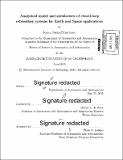Analytical model and simulations of closed-loop rebreather systems for Earth and Space applications
Author(s)
Josan-Drinceanu, Ioana
DownloadFull printable version (30.44Mb)
Other Contributors
Massachusetts Institute of Technology. Department of Aeronautics and Astronautics.
Advisor
Olivier L. de Weck.
Terms of use
Metadata
Show full item recordAbstract
Humans in extreme environments, regardless of whether in space or deep in the oceans of the Earth, rely on life support systems to be kept alive and perform their exploration missions. Diving is similar to extravehicular activities in its duration and the need for human respiratory sustaining. This thesis presents the development of an analytical rebreather model, which is the system that recirculates and conditions the air the diver is breathing during a dive. The capability of simulating rebreather performance is currently lacking in the diving commercial and military industry. We believe that the advantages of having such a model are multi-fold: it can be used for mission planning, evaluating the impact of adding a new technology or modifying existing parameters or operational regime on an hardware configuration without performing expensive and time consuming hardware tests. An analytical model, like the one developed in this thesis, can also be used in complement with hardware testing to fine tune systems and increase resource endurance through the application of different electronic control strategies. The developed Matlab/Simulink model of this rebreather is modular and can be generalized to study open, semi-closed or closed circuits, in which the breathing gas used is air, oxygen, nitrox or heliox. The system's operational environment can be the ocean's surface (1 atmosphere), space (less than 1 atmosphere pressure) or deep underwater (more than 1 atmosphere pressure). After introducing the analytical modeling process for the rebreather, this thesis goes on to explore the model's applications for the study of different oxygen control strategies in order to maximize the oxygen lifetime during a dive, as well as the model's applicability as an aid in accident investigations. We aim to determine what is the maximum endurance of a rebreather system, given a particular, set configuration of components, as well as to study the reverse problem: if we set a mission endurance, what architectures would be able to achieve this level? Additionally, we are interested in studying how the tradespace of diving depth versus the diving systems's endurance looks like and how more complex control methods can help in pushing the existent boundary toward higher endurance limits. We show that more complex control algorithms can extend the duration of the oxygen tanks in a rebreather by a factor of 6.35, and, when given a set endurance level, control can help lower the tank sizes by a factor of 4.
Description
Thesis: S.M., Massachusetts Institute of Technology, Department of Aeronautics and Astronautics, 2015. Cataloged from PDF version of thesis. Includes bibliographical references (pages 181-187).
Date issued
2015Department
Massachusetts Institute of Technology. Department of Aeronautics and AstronauticsPublisher
Massachusetts Institute of Technology
Keywords
Aeronautics and Astronautics.